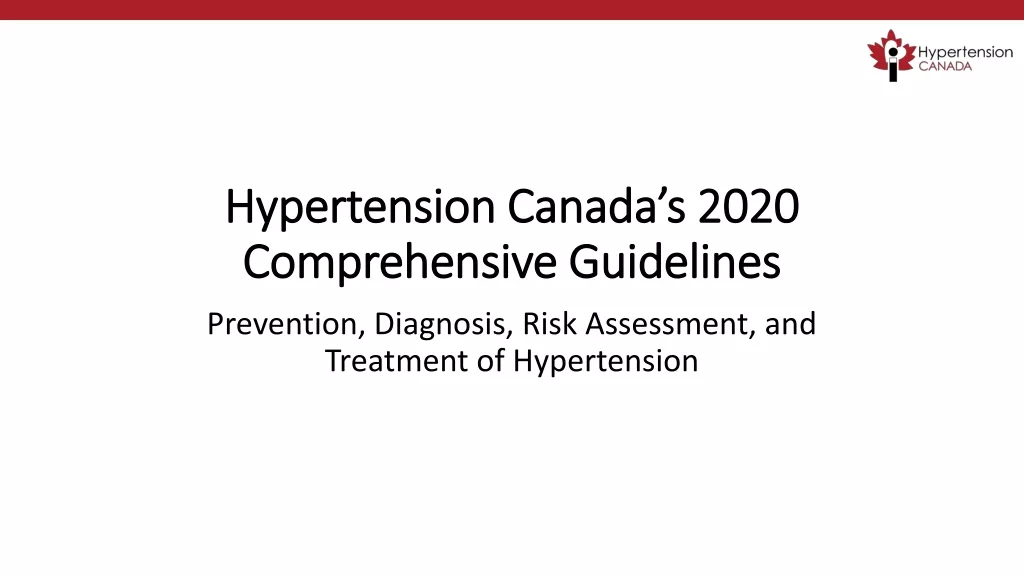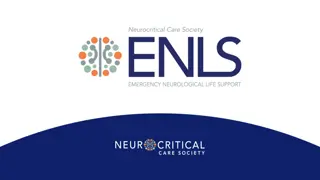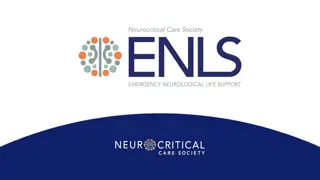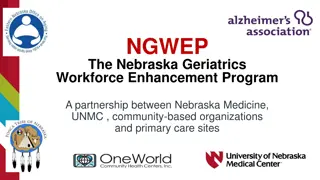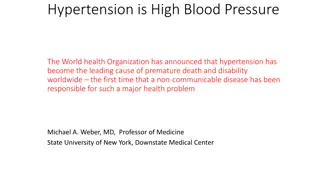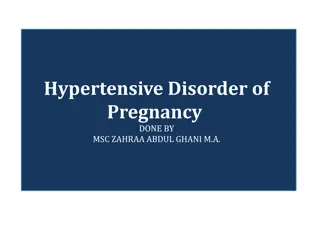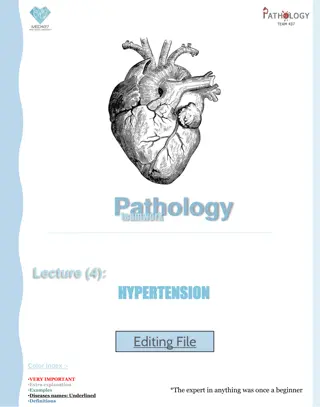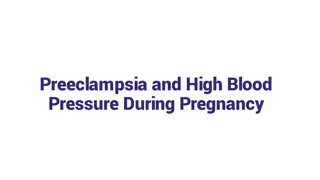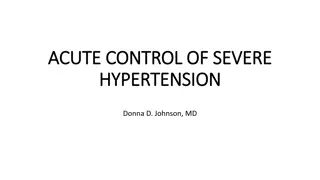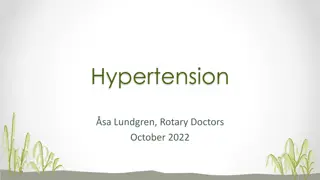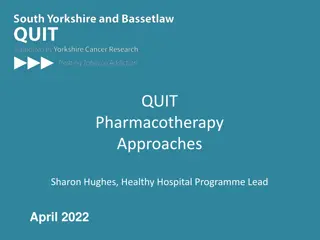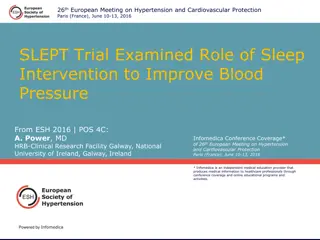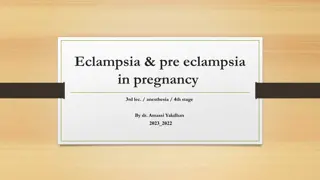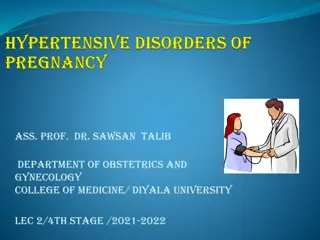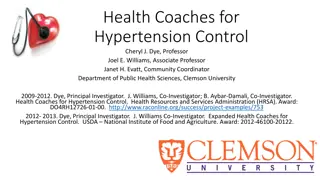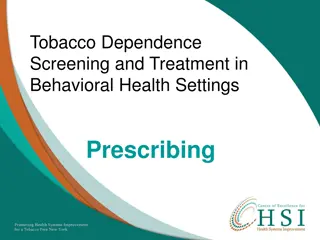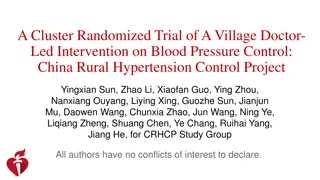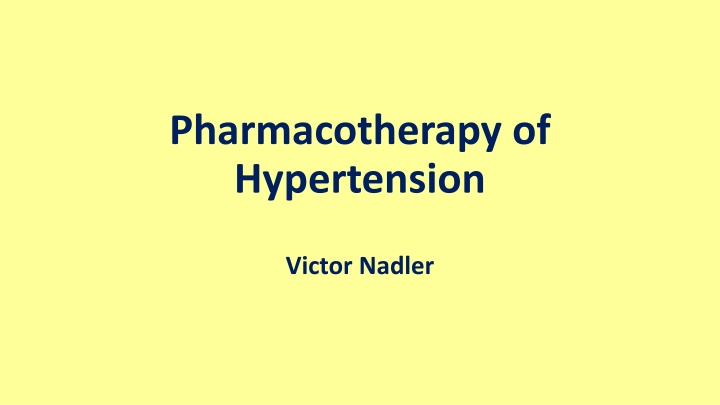
Pharmacotherapy of Hypertension - Key Concepts and Guidelines
Learn about essential hypertension, risk factors, and the role of pharmacotherapy in managing high blood pressure. Discover key reference materials and understand the epidemiology, severity classification, and treatment options for hypertension.
Download Presentation

Please find below an Image/Link to download the presentation.
The content on the website is provided AS IS for your information and personal use only. It may not be sold, licensed, or shared on other websites without obtaining consent from the author. If you encounter any issues during the download, it is possible that the publisher has removed the file from their server.
You are allowed to download the files provided on this website for personal or commercial use, subject to the condition that they are used lawfully. All files are the property of their respective owners.
The content on the website is provided AS IS for your information and personal use only. It may not be sold, licensed, or shared on other websites without obtaining consent from the author.
E N D
Presentation Transcript
Pharmacotherapy of Hypertension Victor Nadler
Objectives By the end of this class students will be able to: Describe the epidemiology of essential hypertension and explain the goals and importance of blood pressure control Describe the contributions of aging, obesity, and salt sensitivity to the development of hypertension Classify the severity of hypertension Match the recommended lifestyle modifications and pharmacotherapy to the severity of hypertension Name the major drugs and drug classes used to reduce blood pressure Describe the actions in the body of each drug, explain the mechanism by which it produces those actions and explain why the drug is useful in treating hypertension
Key Reference for Antihypertensive Therapy Whelton, PK et al., 2017 ACC/AHA/AAPA/ABC/ACPM/AGS/APhA/ASH/ASPC/NMA/PCNA Guideline for the Prevention, Detection, Evaluation, and Management of High Blood Pressure in Adults, www.hyper.ahajournals.org.
Essential Hypertension Arbitrarily defined as a blood pressure 130/80 mm Hg. By this criterion, 46% of American adults are hypertensive. Essential hypertension accounts for >85% of all hypertension Hypertension is a symptom, not a disease. The underlying disease is a cardiovascular abnormality that leads to morbid events. Many causes, all thought to be genetic in origin Environmental and psychosocial factors interact with the genetic background to produce the hypertensive phenotype.
Risk Factors Progression to symptomatic cardiovascular disease is influenced by modifiable and relatively fixed risk factors. Modifiable Smoking, diabetes, dyslipidemia, overweight/obesity, physical inactivity, unhealthy diet Relatively fixed Age, salt sensitivity, chronic kidney disease, male gender, family history, low socioeconomic/educational status, obstructive sleep apnea, psychosocial stress
Secondary Hypertension Accounts for <15% of hypertension Examination should seek to exclude this possibility, especially in patients with resistant hypertension Physical findings suggestive of secondary hypertension Abdominal or flank masses (polycystic kidneys) Abdominal bruits (renovascular disease) Delayed or absent femoral arterial pulses or BP in lower extremities (aortic coarctation) Truncal obesity with pigmented striae (Cushing Syndrome) Tachycardia, orthostatic hypotension, sweating, pallor (pheochromocytoma)
Morbid Outcomes of Chronic Hypertension High blood pressure is the leading cause of death and disability- adjusted life years worldwide. In the United States, hypertension accounts for more deaths from cardiovascular disease than any other modifiable risk factor and is second only to smoking as a preventable cause of death for any reason. The percentage of cardiovascular events attributable to hypertension is greater in women (32%) than in men (19%) and in African- Americans (36%) than in white Americans (21%). Morbid outcomes include congestive heart failure, stroke, renal failure, and retinopathy.
Effective Pharmacotherapy Improves Outcomes CHF Stroke LVH CV Deaths Coronary Events ->50% -35-40% -34% -21% -20-25%
Hypertension Increases Cardiovascular Risk in a Log- Linear Fashion
Example: Impact of Blood Pressure on Renal Disease Systolic Diastolic Range (mm Hg) Adjusted RR Range (mm Hg) Adjusted RR <117 1.0 <75 1.0 117-123 1.0 75-79 1.3 124-130 1.5* 80-85 1.4* 131-140 2.2* 86-91 2.0* >140 5.0* >91 4.0*
Intensive Blood Pressure Control More Effectively Reduces Cardiovascular Morbidity and Mortality NEJM, 373, 2103-2116 (2015). The SPRINT Trial. Standard treatment: BP goal of <140 mm Hg systolic; Intensive treatment: BP goal of <120 mm Hg systolic Intensive treatment group experienced significantly less progression to symptomatic CVD and lower all- cause mortality. However, rates of hypotension, syncope, electrolyte abnormalities, and acute kidney injury or kidney failure were higher in the intensive treatment group. Thus it was decided that a BP goal of 130/80 mm Hg offered the optimal balance of benefit vs risk.
Effect of Age Age Men (% hypertensive) Women (% hypertensive) 20-44 yr 30 19 65-74 yr 77 75 Individuals who are normotensive at 55 years of age have a 90% lifetime risk for developing hypertension. The age-related increase is usually in systolic blood pressure, with little change or even some decrease in diastolic blood pressure. This condition, referred to as isolated systolic hypertension, is therefore characterized by increased pulse pressure (systolic diastolic). In persons older than 50 years, systolic blood pressure of more than 140 mm Hg is a much more important cardiovascular disease risk factor than diastolic blood pressure.
Effect of Obesity Men (% obese) Women (% obese) White American 34 33 African-American 38 58 Obesity (BMI >30 kg/m2) accounts for at least 40% of hypertension. There is an almost linear relationship between blood pressure and BMI. The relationship between blood pressure and waist-to-hip ratio or central fat distribution is even stronger. Obesity increases the relative risk of being or becoming hypertensive by a factor of 2.7; achieving normal weight reverses this risk completely.
Salt-Sensitive vs Salt-Resistant Some individuals respond to high salt with a 10-20 mm Hg increase in systolic blood pressure and to low salt with a similarly large reduction. These individuals are said to be salt-sensitive or to have salt-sensitive blood pressure (SSBP). Other individuals evidence little or no change in blood pressure with changes in salt intake. These individuals are said to be salt-resistant or to have salt-resistant blood pressure (SRBP). These distinct responses to dietary sodium are thought to result from differences in the efficiency of normal sodium handling mechanisms (renal transport, aldosterone, natriuretic peptides, renal eicosanoids, etc). In salt-sensitive persons, one or more of these mechanisms is thought to be impaired. Thus poor sodium regulation by the normal mechanisms requires elimination of a salt load by pressure natriuresis. Conversely, sodium homeostasis in the face of low intake requires a blood pressure reduction.
Effect of Salt Sensitivity Salt sensitivity is especially common in African-Americans, the elderly, those with higher blood pressure, and those with certain comorbidities including chronic kidney disease, diabetes, and metabolic syndrome. Salt sensitivity is largely driven by genetics (est. 75% in African-Americans, about double the estimated genetic involvement in hypertension). Salt sensitivity is an independent risk factor for cardiovascular disease. That is to say, salt- sensitive persons are at increased risk of developing symptomatic cardiovascular disease even if they are not hypertensive. It is important to distinguish between hypertension and salt sensitivity; the one does not necessarily imply the other. Salt sensitivity is accompanied by several other abnormalities that include (1) a blunted response of the renin-angiotensin system to changes in sodium, (2) impairment of both the production and action of NO increasing oxidative stress, (3) hyperactivity of the sympathetic nervous system, and (4) hyperinsulinemia. The last three of these contribute to cardiovascular pathology.
Hypertension in African-Americans The prevalence of hypertension in African-American adults (men: 59%; women: 56%) is among the highest of any population in the world. Hypertension increases cardiovascular risk more in African-Americans. Ex: the same elevation in blood pressure increases the risk of stroke three times more in African- Americans than in white Americans. African-Americans are 50% more likely to be obese than white Americans, particularly African-American women. About 70% of hypertensive African-Americans are salt-sensitive. Hypertensive African-Americans have a higher average blood pressure than other hypertensive populations. This higher blood pressure requires more aggressive therapy to achieve the treatment goal. Thus African-Americans are more likely than others to develop resistant hypertension.
Hypertension-Related Morbidity and Mortality in African- Americans Compared to Other Americans Rates for African-Americans vs Other Americans Overall mortality 6-13X Non-fatal stroke 1.3X Fatal stroke 3-6X Heart disease death 1.5X End-stage renal disease 5X
Epidemiology of Essential Hypertension White American African-American Prevalence 33% 43% Diagnosed 81% 87% Pharmacotherapy 77% 80% Control with drugs 56% 48% Circulation. 2017;136:e393 e423. DOI: 10.1161/CIR.0000000000000534. Hypertension defined here as blood pressure >140/90 mm Hg.
Classification of Blood Pressure Category Systolic (mm Hg) Diastolic (mm Hg) Normal <120 and <80 Elevated 120-129 and <80 Hypertension Stage 1 130-139 or 80-89 Stage 2 140 or 90
Diagnosis Based on the average of two or more blood pressure measurements separated by 1-2 min repeated at two or more visits. The patient must be seated in a comfortable chair for at least 5 min before and during the measurement. At the first visit, blood pressure is recorded in both arms; use the arm that gives the higher reading for all subsequent measurements. Out of office blood pressure measurements are recommended to confirm the diagnosis of hypertension and for titration of medication. These additional measurements are needed to exclude the possibilities of white coat hypertension (20/10 mm Hg higher in the office than at home) and masked hypertension (20/10 mm Hg less in the office than at home).
Treatment Guidelines Category Recommended Treatment Normal blood pressure Reassess in one year Elevated blood pressure Lifestyle modifications; reassess in 3-6 months Stage 1 hypertension with 10-year ASCVD risk <10% Lifestyle modifications; reassess in 3-6 months Stage 1 hypertension with 10-year ASCVD risk 10% Lifestyle modifications Medication Stage 1 hypertension with symptomatic CVD Lifestyle modifications Medication Stage 2 hypertension, blood pressure <150/90 mm Hg Lifestyle modifications Medication Stage 2 hypertension, blood pressure 150/90 mm Hg Lifestyle modifications Two first-line medications from different classes
Lifestyle Modifications Modification Recommendation Expected Reduction in Systolic BP Weight reduction Maintain normal body weight (BMI of 18.5- 24.9) 1 mm Hg for each kg lost Adopt the DASH diet Consume diet rich in fruits, vegetables, and low-fat dairy products with reduced saturated and total fat up to 11 mm Hg Dietary sodium reduction Reduce intake to no more than 1500 mg NaCl per day variable (0 up to 10-20 mm Hg depending on salt sensitivity/resistance) Increase dietary potassium Optimal intake is 3500-5000 mg per day, preferably through healthy diet 4-5 mm Hg (possibly double this in persons who eat a high sodium diet) Physical activity Engage in aerobic physical activity (e.g., brisk walking) for at least 150 min/week 5-8 mm Hg Moderation of alcohol consumption No more than 2 standard drinks per day for most men and no more than 1 for women 2-4 mm Hg Stop Smoking!
Results of the DASH Study The combination diet was more effective and is now the standard DASH diet. The standard DASH diet substitutes low-fat dairy products for much of the meat and sweets in the normal diet and includes twice the national average consumption of fruits and vegetables. The mechanism of the blood pressure reduction remains unknown. The DASH diet is enriched in potassium, calcium, magnesium, and fiber, and these properties may play a role. The standard DASH diet is neutral with regard to calories and sodium. If weight loss or reduced sodium intake is desired, then a low-calorie or low-sodium version of the DASH diet must be followed. The DASH diet is rather bland and only ~20% of hypertensive persons adhere to it long-term. Personal preferences and cultural influences must be considered when designing dietary therapy.
Lifestyle Modifications vs Drugs Reasonable adherence to the recommended lifestyle modifications can reduce blood pressure as much as a single first-line antihypertensive drug. In salt-sensitive persons, strict adherence to a low-sodium DASH diet can reduce blood pressure a good deal more. Lifestyle modifications may therefore substitute for at least one drug in the antihypertensive regimen. However, adherence to lifestyle modifications is worse than adherence to pharmacotherapy. For example, a low sodium diet is difficult to maintain. Most dietary sodium comes from additions during food processing or during commercial food preparation. Patients may have to prepare their own food from the raw ingredients.
Blood Pressure Variables P1 Mean arterial pressure (= diastolic blood pressure + 1/3 of the pulse pressure) P2 Central venous pressure (relatively low and essentially constant) Q Cardiac output Viscosity L Length of the vasculature R Radius of the arterioles Large effect on blood pressure with little change in r
POISEUILLE EQUATION ( Q = ) 4 8 8 P P r 1 2 L LQ r = P P 1 2 4 Thus the most effective way to reduce blood pressure is to dilate arterioles ( r). All first-line antihypertensive drugs work by increasing r.
Antihypertensive Drugs First-line; best reduce cardiovascular morbidity and mortality Thiazide diuretics (chlorthalidone, hydrochlorothiazide) ACE inhibitors (lisinopril)/AT1 receptor antagonists (ARBs; candesartan) Calcium channel blockers (amlodipine, verapamil, diltiazem) Second-line Beta blockers (atenolol, metoprolol, carvedilol, nebivolol) Alpha blockers ( 1-selective; prazosin) Resistant hypertension Potassium-sparing diuretics (spironolactone, eplerenone, amiloride, triamterene) Third-line (not covered) Sympatholytic agents (clonidine, reserpine, guanethidine) Direct-acting vasodilators (hydralazine, minoxidil)
First-Line Antihypertensive Drugs Combat Cardiovascular Remodeling Remodeling (resulting in arteriosclerosis and/or congestive heart failure) may include oxidative damage, overgrowth of smooth muscle or cardiac muscle, fibrosis, apoptosis of cardiac muscle, overgrowth of connective tissue, endothelial damage, etc. Factors that promote remodeling include (among others) excess sodium, glucose, angiotensin II, catecholamines, aldosterone. NO inhibits remodeling. First-line antihypertensive drugs reduce cardiovascular morbidity and mortality even if they little reduce blood pressure. This additional benefit, beyond that provided by blood pressure reduction, may be explained by inhibition or reversal of remodeling.
Thiazide Diuretics Mechanism Short-term reduction in extracellular fluid, therefore reduced cardiac output Long-term reduction in peripheral resistance from opening of potassium channels in vascular smooth muscle, increased NO production and action, and ?* Notes Thiazide diuretics reduce blood pressure about equally in all population groups.* Chlorthalidone is preferred for monotherapy.* Better reduces progression to symptomatic CVD Longer duration of action More effectively opens K+ channels in vascular smooth muscle The great majority of thiazide-containing combinations, however, utilize hydrochlorothiazide. Use a loop diuretic only if it is needed to treat congestive heart failure or chronic renal disease.*
ACE Inhibitors Molecular Mechanism Competitive inhibition of angiotensin converting enzyme (kininase II), thus reducing production of angiotensin II* Physiological Mechanisms Block of angiotensin II-mediated vasoconstriction* norepinephrine release by block of angiotensin II-mediated enhancement sympathetic outflow from the brain stem bradykinin-mediated vasodilation aldosterone secretion (reverses in many cases)* Block of angiotensin II-mediated arterial and left ventricular remodeling*
ACE Inhibitors Adverse Effects Dry cough (partly caused by bradykinin)* Rapid swelling of nose, throat, mouth, tongue (angioedema; partly caused by bradykinin)* Teratogenesis in the second and third trimesters (malformed kidneys)* Hyperkalemia (especially in the absence of diuretic)*
AT1 Receptor Blockers (ARBs) Molecular Mechanism Competitive antagonism of angiotensin II at the AT1 receptor* Physiological Mechanisms Block of angiotensin II-mediated vasoconstriction* norepinephrine release by block of angiotensin II-mediated enhancement sympathetic outflow from the brain stem aldosterone secretion (reverses in many cases)* Block of angiotensin II-mediated left ventricular remodeling*
Notes on ACE Inhibitors/ARBs All generic drug names of ACE inhibitors end in pril. All generic names of ARBs end in artan.* ACE inhibitors and ARBs are about equally efficacious and are less effective than thiazide diuretics or calcium channel blockers in slowing progression to symptomatic CVD. Less effective in salt-sensitive individuals, because such individuals have a blunted renin-angiotensin system.* If cough is intolerable with ACE inhibitor or angioedema develops, switch to an ARB or just use an ARB instead.* Use ACE inhibitor or ARB in persons with congestive heart failure, chronic kidney disease, and/or who are post-MI.* Do not combine an ACE inhibitor with an ARB. Do not substitute an ACE inhibitor for an ARB.*
ACE inhibitors (and ARBs) reduce blood pressure less effectively in African-Americans than thiazide diuretics (or calcium channel blockers). The combination of ACE inhibitor (or ARB) and thiazide diuretic reduces blood pressure equally well in all populations.
Calcium Channel Blockers Molecular Mechanisms Reversible block of L-type Ca2+ channels in vascular smooth muscle cells (all)* Reversible block of L-type Ca2+ channels in cardiac muscle cells* (verapamil, diltiazem only) Physiological Mechanisms sympathetically-mediated vasoconstriction due to block of Ca2+ action potentials and Ca2+-mediated Ca2+ release from sarcoplasmic reticulum (all)* inotropy, cardiac output (verapamil, diltiazem only)*
Calcium Channel Blockers Adverse Effects Reflex tachycardia (risk in ischemic heart disease; nifedipine, diltiazem, but not amlodipine or verapamil)* inotropy (verapamil, diltiazem only)* Edema from precapillary dilatation with reflex postcapillary constriction (all) Reflux due to relaxation of the lower esophageal sphincter (all) Notes All generic names of vascular-specific calcium-channel blockers end in -dipine.* Calcium channel blockers reduce blood pressure about equally well in all population groups.* Verapamil or diltiazem should be used in preference to a vascular-specific drug to treat hypertension in persons with diastolic congestive heart failure, stable/unstable angina, or supraventricular arrhythmia.*
Beta Blockers Molecular Mechanisms Major importance Competitive antagonism of 1 adrenergic receptors (atenolol, metoprolol)* Competitive antagonism of 1, 2, 1, anti-oxidant and anti-apoptotic effects (carvedilol)* Competitive antagonism of 1 + increased NO availability (nebivolol)* Lesser importance + intrinsic sympathomimetic activity (acebutolol) + 2 agonist activity (celiprolol) + 2 antagonist activity (propranolol) + CNS depression (propranolol)
Beta Blockers Physiological Mechanisms Major myocardial contractility (reduced cardiac output)* Others renin secretion norepinephrine release by block of positive 2 feedback sympathetic outflow from the brain stem Block of catecholamine-induced cardiac remodeling* Vasodilation (carvedilol, nebivolol)*
Beta Blockers Adverse Effects inotropy and chronotropy* (mainly 1 antagonism). Blunt recognition of hypoglycemia. Bronchoconstriction* ( 2 antagonism) Block of epinephrine-mediated vasodilation of skeletal muscle beds ( 2 antagonism) Glycogenolysis and blood glucose ( 2 antagonism) Plasma triglycerides and HDL ( 2/ 3 antagonism) Carvedilol (combined 1, 2, 1 antagonism) and selective 1 antagonists minimize metabolic effects of beta blockers)* Exercise intolerance* ( 1- and 2-mediated) Carvedilol and nebivolol cause little or no exercise intolerance. Sexual dysfunction* Nebivolol produces less.
Notes on Beta Blockers Beta blockers were first-line antihypertensive drugs for years, but have been found to reduce progression to symptomatic cardiovascular disease less well than the current first-line agents. Beta blockers should be used in persons with congestive heart failure, stable/unstable angina, supraventricular arrhythmia, and/or who are post-MI. Agents that block 1 receptors and have vasodilatory properties (e.g., carvedilol, nebivolol) are particularly useful in heart failure patients and in patients with hyperlipidemia or prostatic hyperplasia.
Alpha Blockers Molecular Mechanism Competitive antagonism of 1 adrenergic receptors* Physiological mechanism Direct postsynaptic blockade of sympathetically-mediated vasoconstriction*
Alpha Blockers Adverse Effects Transient reflex in heart rate, cardiac output, plasma renin* (risk in ischemic heart disease) Depression of the baroreceptor reflex, leading to orthostatic hypotension* Edema (similar to Ca2+ channel blockers) Other Actions total and LDL cholesterol, HDL cholesterol Relaxation of prostate and bladder smooth muscle* Alpha blockers are most useful in patients with prostatic hyperplasia who may be receiving a drug of this type anyway.*
Resistant Hypertension Defined as blood pressure that remains above goal despite the concurrent use of three first-line antihypertensive drugs from different classes, including a diuretic. Before concluding that a patient truly has resistant hypertension, check the technique for measuring blood pressure, the possibility of a secondary cause, the choice of drugs and dosing regimen, adherence, and associated comorbidities. Most cases of resistant hypertension are though to arise from occult expansion of extracellular fluid volume and/or from increased production or action of aldosterone. Salt sensitivity and higher blood pressures are major risk factors. Treatment Reduce dietary sodium intake as much as possible Add on a potassium-sparing diuretic

